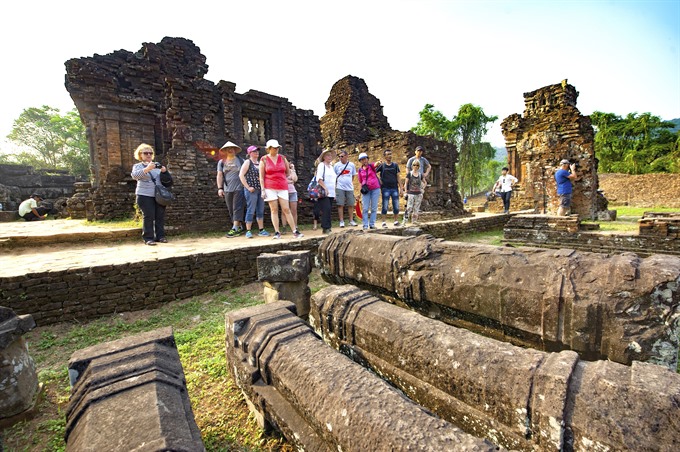
Tourists visit Mỹ Sơn Sanctuary – UNESCO’s World Culture Heritage Site – in central Quảng Nam Province. VNA/VNS Photo Minh Đức/Asia News Network
HANOI — Vietnam wants to make tourism a key economic sector by 2020 that creates a driving force for the development of other sectors.
The country expects to attract 17-20 million foreign visitors and 82 million domestic ones by then.
Visitors are expected to spend US$35 billion in the country in 2020, on-the-spot exports through tourism are expected to reach $20 billion and the sector is hoped to create jobs for four million people including 1.6 million direct jobs.
Such ambitious goals are part of a Politburo resolution on developing tourism into a key economic sector, issued early this year.
Nguyen Van Tuan, General Director of National Administration of Tourism, told a workshop on restructuring Vietnam’s tourism sector yesterday that the resolution created motivation for the sector’s development and it also helped change public awareness about tourism – as not a single sector but a collective one relating to other sectors.
He said that last year, Vietnam welcomed 10 million foreign visitors and the World Tourism Organisation ranked it in top ten countries with highest tourism growth globally.
In 2017, Vietnam expected to host 13 million foreign visitors and it was ranked in top six countries with highest tourism growth, Tuan said, adding that the expectation would likely become real and the National Administration of Tourism would greet the 13 millionth visitor nextweek.
“The tourism sector made achievements but these are still modest compared to Vietnam’s tourism potential and expectations as well as those made by neighbouring countries,” Tuan said.
“Restructuring is an urgent need for Vietnam’s tourism sector,” he said, noting six issues that need restructuring – resources and funding for tourism, tourism products, developing tourism markets, tourism companies, human resources for tourism and management.
Vietstar Airlines Deputy General Director Luong Hoai Nam said that Vietnam’s tourism was “good at some things but bad at many things.”
Last year, Vietnam received 10 million foreign visitors but Thailand received 32.6 million, Malaysia 26.8 million, Singapore 16.4 million and Hong Kong 26.7 million.
Cambodia, with a population of about 15 million people, received 5 million foreign visitors. This means a neighbouring country with a population a sixth as big as Vietnam has welcomed half as many visitors.
Nam said that with advantages in natural resources and human resource, Vietnam’s tourism was hindered by bottlenecks relating tovisa policies, information and communications technology readiness, health and hygiene, safety and security, airport infrastructure, ground and port infrastructure and tourist service infrastructure.
According to Travel and Tourism Competitiveness Index 2017 of World Economic Forum, Vietnam’s tourist service infrastructure ranked 113 out of 136 economies.
“Few tourist products with high creativeness are available in Vietnam,” Nam said, adding that there are opportunities to developnew tourist products based on the conditions of individual localities.
Certain types of tourism could be exploited, for example, war tourism allows visitors to learn about wars in Vietnam through battle sites, golf tourism is popular in Asia and hiking and trekking tourism has possibilities as Vietnam has much natural beauty.
Vietnam ranked 82th out of 136 economies in the same survey index in terms of health and hygiene, necessitating an improvement in fighting rubbish and better quantity and quality of public toilets.
In addition, Nam said that the country should have opener visa policies for tourists.
“The matter is not the visa fee but the inconvenience and displeasure people experience when applying for a visa,” he said.
Vietnam exempts tourist visa for citizens from 23 countries but Thailand does the same for 61 countries, Singapore 157 countries, Malaysia 155 countries, Indonesia 169 countries and the Philippines 157 countries.
Nguyen Quoc Ky, chairman and director general of Viettravel said tourism consists of four major components – travel, accommodation, transport and services. So, restructuring the tourism sector means implementing synchronised measures in related sectors like transport,commerce, services and customs.
Nguyen Dinh Cung, director of the Central Institute for Economic Management said that investment priority should be given to developing tourist infrastructure.
In any economic restructuring plan, enterprises should be placed at the centre, he said, calling for stronger administrative reform and improved business environment so enterprises can run freely, safely and more creatively.